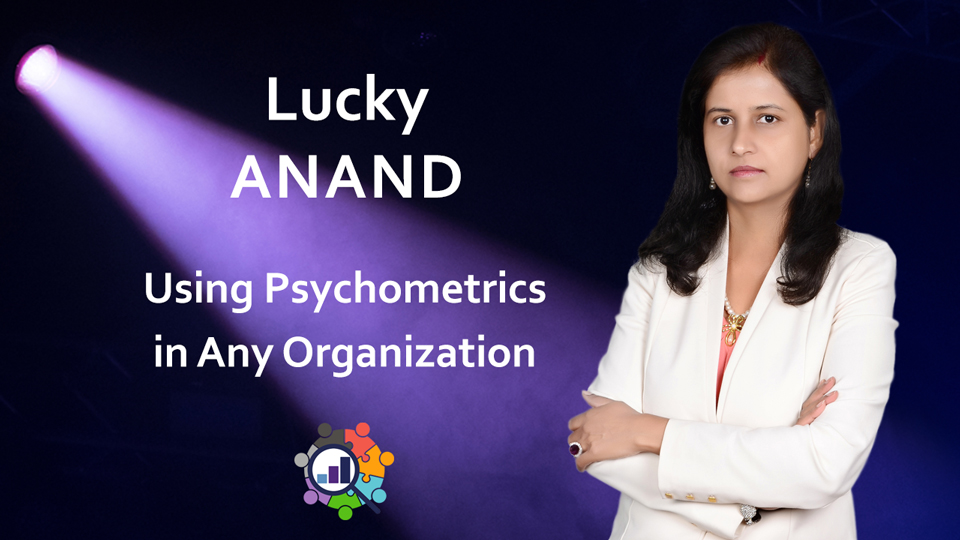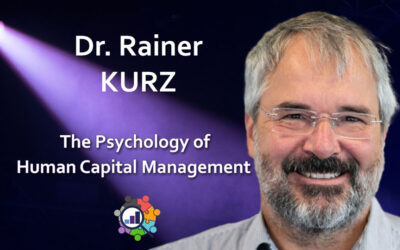A CykoMetrix Spotlight Production
Every week, the Spotlight shines on an amazing professional with a story to tell and lessons to teach. Welcome to the CykoMetrix Spotlight.
The following is an adapted transcript of the exchange between Sylvain Rochon, CMO at CykoMetrix as host, and Lucky Anand CEO of Plan My Trainings & Director of Salahkaar Consultants (www.Lucky.in.net)
Sylvain Rochon: Welcome to CykoMetrix Spotlight. My name is Sylvain Rochon, the Chief Marketing Officer at CykoMetrix, a leading-edge psychometric and human data analytics company that brings the employee assessment industry to the cloud with instant assessments, in-depth analysis, trait measurements, and team-based reporting features that simplify informed decision-making around recruiting, training, and managing today’s modern workplace.
I have with me a fantastic person from India. Her name is Lucky Anand. She is a Senior HR Professional. She has headed HR organizational development and training divisions in various small, mid, and large-scale organizations. She’s handled human resource outsourcing for startups. She has extensive experience of more than 22 years in HR, assessment centers, organizational development, talent acquisition, training, and psychometrics. She is an author, a trainer, and a speaker by passion. So, kindred to me. She’s the founder of PlanMyTrainings.com. She is the Director of Salahkaar Consultants, Director of Xcelanta Services, and she is also a founder of the WHD Forum Foundation. She’s also serving as President at Chalk and Duster Toastmasters Club. Thank you for being here, Lucky, into the spotlight.
Lucky: Thank you, Sylvain.
Sylvain: Thank you so much. Now, we’ve talked about this before, where we always do a pre-interview discussion and I was fascinated to learn that you are in-depth, just like we are, into the psychometric assessments arena. If I remember correctly, you create assessments specializing in the Indian market. In part because of that, you’ve been deploying assessments and looking into how they are used in organizations. We decided together that we should talk about your expertise, which is using these assessments in any kind of organization and how they are deployed, how they are useful. Why don’t we start by you telling us your ideas surrounding psychometrics and their use in general?
Lucky: First of all, thank you for inviting me for this conversation. It’s absolutely wonderful to speak with you since we have similar interest areas. Of course, it’s a pleasure and, again, thanks. To start with, it has always been that my interest area has been into the human development arena. When I started my professional life, the initial career, the initial opportunities that I got, I was really fortunate, I was lucky to get opportunities wherein I could work actually in the human resource development areas.
When I started working about 22 years back. Before that HRD as a function was not there in the market. Most of the organizations actually didn’t have the HRD department itself. There were personnel departments, there were administration departments, but HRD was not prevalent. When I got my first appointment, that was a German multinational. This organization, in fact, was an Indian company, and it had been taken over by a German company just before I joined. That was my first opportunity to work on setting up the HR systems, the HRD part, development of people, development of the organization, those aspects. That’s where I started knowing about competencies, about assessments.
The first thing that I started off were around the job descriptions, identifying the job descriptions, appraisal system making that for the organization. Then we moved on to training and we evolved into identifying the competencies, doing the assessments, all those things. The organization evolved in those areas in about 3 years span of time. That’s where I started researching. I started approaching other organizations who were having the psychometric testing as one of their key functions in their organization, and also competence, how they use the psychometric testing and their competency assessment and all those things. I started researching that, and I started implementing that.
That’s where my interest developed in this area. It’s been more than 19 years that interest in this area has been there. Then I got associated with Salahkaar Consultants, who were also pioneering the concepts of psychometrics in Indian corporate. I got associated with them. I got certified by them on psychometric assessment and psychometric testing. Then I left my corporate job and got into full-time consulting with them. We started doing programs on psychometric testing for people from corporate. We were the pioneers in building up training programs for people. We brought psychometrics to the Indian market. We started teaching and, of course, the founder of Salahkaar Consultant. In fact, together we took this as an opportunity to build tests which were relevant for Indian market. The founder, along with the team left more than 35 tests, which were similar to the tests that were internationally well known, but were typically relevant for the Indian market, for Indian people, and Indian culture. That’s how it started off. I then used these tests in various organizations, various setups, and various requirements. It’s been in use for various reasons and by various organizations since then.
Sylvain: Is this a, 20-year time span, right? From what you are describing, going from companies in India specifically because that was your experience of going from personnel and admin departments handling everything that is more the administrative aspects of HR, what we call it today. Then moving that to an actual human resource and development approach using assessments. My question would be, what kind of business case or results or KPIs actually convinced the executives to move from where they were to development? Executives don’t take a decision without having some kind of results out of it. What did you observe in those 20 years that provoked that shift?
Lucky: There are many facets to it. One is, of course, these terms and processes were prevalent in the western region of the world. A lot of concepts came from there. In my organization, wherein this was an Indian organization, and this was taken over by a German company. There was a lot of influence on what was going on in Germany and from there, the systems were being adopted. That was one part. Even the HR professionals were getting accustomed to what was happening in the world. People were trying to adjust to the changes that were happening around. Apart from India, what was happening in the other regions of the world? And of course, when these things are implemented, then results show, absolutely. I can share with you an example of one of my clients. This was a very unique plan and very unique intervention we did for this organization. The client’s requirement was that they were setting up a new factory. So, they were about to hire around 500 people in the new factory. Their requirements with which they came to us as a consulting firm, they came to us that they need people who do not have leadership qualities.
The requirement was very unique, that’s what I’m saying. Normally, people come asking that, okay, we want to hire people and we want them to be having leadership qualities, having qualities like innovation, and they should be taking initiatives, those kinds of things. Whereas here, it was totally opposite.
They wanted people who do not have initiative, who are very down to earth, and who do not want to change things very often. They are docile, and they do not want the systems to change. They do not want to take initiative. They are low on leadership qualities. That was the requirement. We did a lot of brainstorming on how to tackle this because most of the tests would test people on leadership qualities, the other way around. Then what we did is we selected a few tests, which would highlight the leadership qualities and all these things, and we used those reports in a reverse manner. Then the result was phenomenal. Why do they want this, first of all? Why this need? The need was there because the function or the kind of job that these people were to handle was a very routine kind of job, which would not change. They have to do some manual labor kind of work, which they have to keep doing. The same work all throughout the entire day. They wanted that these people should not emerge as labor union leaders, all those things. It should not happen in our plant. People should remain calm. They should not be unrest and all those things in the plant. That way, they wanted this kind of hiring. Based on their requirement, we shared our reports.
The result was that they did not have labor unions for 5 years. We were associated with them for the entire hiring for about 2 years. Based on our recommendations, the hirings were done. For the next 5 years, they did not have any problems. After that, I don’t know. We were not associated because the recruitment was done and all those things were done. I didn’t get any news after that on how it went along, but at least we kept track for the next 5 years of how it went, and the results were phenomenal. The kind of people they wanted, they had that. They didn’t have any unrest, and everything was smooth, at least for the next 5 years.
Again, there was another thing I would like to add to this. We also did psychomotor test, which was complementary to psychometric. The kind of tests like hand-eye coordination and two-hand coordination. Those kinds of tests were also there. This was that way a complete, unique package of services that we gave to this client.
Sylvain: That’s a combination of two types of tests, in this case, to identify candidates that were most satisfied with their requirements but there was some logic to that kind of like no leaders type of requirement, which I agree that it is typically unusual. About 75% of companies nowadays, especially the medium to large ones, do use psychometrics for hiring. It is a growing trend to get the right people in the right positions, with the right attitudes. So, do you have a case study when psychometrics has been used interestingly for continuous development, which is another fairly common use of psychometrics to spend a training budget basically by HR? What do you think about that?
Lucky: Yes, we have used that as well. Not only for training but even for promotions for building the pipeline. For all those things, yes, it is used. We have also used it for giant steel organizations. We have done for them a complete assessment based on psychometric testing. We not only use one test, but we use a combination of various tests to understand the complete personality of the managers. Based on that, we did the complete career path for those managers, building up the career path for them, and then also training them, identifying the training needs of managers. Yes, of course, that way, it is used. Not only that but even as a trainer. I’m also a trainer. As a trainer also, there is also a test that we have developed in-house, which is the Enneagram Test. It is called as Enneagram because it is based on 9 types. Ennea is 9 and Gram is figure. That way it is named Enneagram. It is based on ancient Sufi traditions. It came from there. We developed this test. It is a wonderful test, which gives reports which is a complete detailed report of personality. It gives reports on how the person’s personality is. It also gives reports on what kind of career is suitable for that person and also on things like what kind of other personalities this person can get along with better. When this person is angry, how would this person behave? When this person is in the best of mood, how does this would person behave? All those things come in that report.
I used this test a lot in my self-discovery program. This is a signature program that I have developed. It is a self-development program, a training program for managers. I use this a lot. This gives a great in-depth understanding to people of their personalities and how they need to develop themselves, what they need to do. While they are interacting with others, what are the things that they should take care of? All those things they get to know with their reports.
Sylvain: Good. Here’s one I’m very interested to hear about. Because you’re living in a different market than the West and you explained to us that India was a little bit behind in using psychometrics versus Europe and perhaps North America when you got started 20-odd years ago. What kind of returns has the Indian market and companies gotten from starting to use psychometrics in their processes like hiring and development? Have you seen a big uptick in activities, performance, and productivity? What have you seen in the Indian market since you participated in introducing the concept into the continent?
Lucky: Yes, of course. In fact, it is seen in India that there has been a very wide usage of psychometrics in all these areas, in recruitment and training. In training, I don’t see much use for psychometrics, other people, I don’t see many trainers using. But yes, some of the well-known tests are used by several trainers on leadership when there is leadership training and all. Some of the well-known tests are used by people, but not in the regular generic training like communication and all. But yes, I have seen that there has been a lot of improvement in the results of organizations when psychometrics are used for recruitment because then you get to hire the right people.
You get to understand that, okay, so this is our team, this is our requirement, this kind of people or this is our culture. So then, based on that, if we hire this kind of person, then this will be a suitable match. Of course, that way, I see the usage of psychometrics a lot. Even the combination of psychometrics, ability tests and all those things are used a lot. Now, many multinationals have their own portals wherein they put the ability tests and psychometric tests, and they use it for hiring, even large organizations like TCS and all. They have their own testing portals. They even certify individuals on various things. Based on their certifications, other organizations also hire. That way, it’s widely used and of course, results are there. As I shared, one of the examples of my client. Results are there and based on that, it is being used very widely.
Sylvain: Excellent. What is the difference? Since you’re making assessments specifically for that subcontinent of India, what are the differences between the assessments in India and those assessments, whether it’s Myers Briggs or whatever assessments are being used outside of India? What kind of changes are you actually making to adapt to the Indian market?
Lucky: Yes. Myers Briggs, the MBTI, it is used very widely in India as well, let me tell you that. It’s not that the Indian market uses only Indian tests, it’s not that. MBTI is used quite widely here as well. In fact, earlier 16PF was used a lot. Now, MBTI is also now getting a little bit replaced by other tests like Big Five and all. For us, it’s like we have developed this 16-personality test, which is pertaining to the Indian culture. We have redesigned the answer pattern. We have redesigned the questions which are relevant to the Indian context. That is what is there because there are certain questions which Indian people do not relate to, which is particularly to Western culture. So because of those kind of things we have made changes and based on that, our tests are also being used by several organizations. We have checked the reliability and the validity of these tests, which is very high due to this aspect, because it got the Indian context to it.
Sylvain: Do you think from your experience like exactly in that space, like adapting to it, do you think there’s a reason to adapt to many other nations and cultures? Because we can certainly use MBTI or whatever assessments, a Big Five, and the inventories that exist. To your point, sometimes some questions are not understood, or the context is different in Japan, South Africa, or wherever. Do you think there’s a need for a business model to actually do a lot of adaptations that are cultural for all sorts of assessments? That’s a lot of work. I should do it if it’s significant.
Lucky: Yes. Absolutely. In fact, this could be a great enhancement to this area if done because the culture varies a lot. In fact, an example I shared with one of our clients, the kind of adaptation we did was that we picked 2, 3 tests and we took few questions from each of them, and we reworded the statements based on the Indian context, and we also made them vernacular. Local languages were used in the test. We tested on the reliability and validity of these tests, and then we used them. This was the entire process we did for some of our clients, and it has proved very successful. Because now, let’s say there are workers to be hired. They do not understand English because their language is Hindi or some regional language. In that case, they would not be able to answer the questions. They would also not be able to relate to the context that is being spoken over there. Right? In that case, these tests prove much better because now they can understand the language. Now they can understand the context. They can understand the questions being asked. Of course, We have seen the results of this input. We have taken these initiatives, and we have seen the results, and it has really proved very fruitful. I think that is a good market for other countries as well.
Sylvain: Yeah. The assumption is that every country has its own culture and their own language that everybody knows but the adaptation is a lot of work. So, I assume, at least I know a lot of countries just take off the shelf what exists because that’s something they can use directly. Most companies don’t have the expertise or the experience or the willingness to spend the time to do an adaptation just for themselves. They hope a company is going to pick that up and do it for them so that they can have a more reliable assessment.
Lucky: Yes. In that case, they can hire consultants like us.
Sylvain: That’s right. Well, I think that’s a good segway into a conclusion. That’s a good point. There is a need. There is a demand for psychometric assessments. CykoMetrix is designed to be a platform to support all that, and Salahkaar Consultant is doing adaptations for India specifically. You have that expertise.
I’m talking now to the audience here. If you want to connect with Salahkaar Consultants or connect with Lucky Anand to pick her brain, get some help with assessments, and get more reliable assessments for your culture perhaps, why not? Maybe you should contact her or Salahkaar Consultants. The information about these organizations is going to be below in the description and inside the blog.
I just want to thank you so much for answering those questions, Lucky, because it is kind of unique being an assessment maker and adapter of assessments, serving a very important need in India. Thank you.
Lucky: Thank you, Sylvain. It was wonderful speaking to you. When we discussed about this psychometric platform that you are doing, I think you are doing a wonderful job of making a marketplace of psychometrics.
Sylvain: That is what we do. Thank you so much.
About Lucky Anand – www.lucky.in.net
Lucky is a senior HR Professional. She has headed HR, Organizational Development and Training divisions in various Small, mid and large-scale organizations.
She is handling human resource outsourcing for startups. She has extensive experience of more than 22 years in HR, Assessment Centre, Organizational Development, Talent Acquisition, Training and Psychometrics. She is an Author, Trainer and Speaker by passion.
She has received various awards for her speaking passion and even for her domain knowledge and skills.
She is the founder of PlanMyTrainings.com. She is a director at Salahkaar Consultants, a director at Xcelanta services and she is also the founder of WHD Forum Foundation. She is also serving as President at Chalk and Duster Toastmasters Club.
About CykoMetrix – www.CykoMetrix.com
CykoMetrix is a leading edge combinatorial psychometric and human data analytics company that brings the employee assessment industry to the cloud, with instant assessments, in-depth analysis, trait measurements, and team-based reporting features that simplify informed decision-making around recruiting, training, and managing today’s modern workplace.



